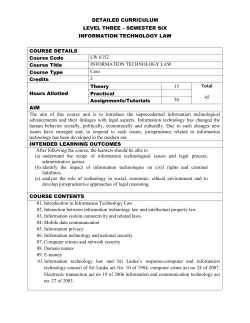
Jonas Cognell, Smart Cities, Göteborg Energi AB
Side event: The combination of district energy networks and heat pumps – the story of Gothenburg Jonas Cognell , Göteborg Energi AB Senior Program Manager, PMO Assisting Coordinator, Celsius, Smart Cities Jonas.cognell@goteborenergi.se Thisproject projecthas hasreceived receivedfunding fundingfrom fromthe theEuropean EuropeanUnion’s Seventh This Union’s Seventh Framework Programme for research, Framework Programme for research, technological development and technological development andgrant demonstration demonstration under agreement under no 314441. grant agreement no 314441. About the Gothenburg Energy Recovered heat Renova 190 MW St1 140 MW Preem 60 MW Perstorp 8 MW Heat pumps 160 MW(Th) Rya CHP, (NG) Heat 300 MW Electricity 260 MW Högsbo CHP (NG) Heat 16 MW Electricty 12 MW Rosenlund CHP (NG) 2013: Steam generator Heat 110 MW Electricty 35 MW Total: 4600 GWh Bio Fuel Sävenäs/Hp3 Heat 110 MW Electricty 14 MW Heat pumps: 425 GWh Rya HVC (woodchips) Heat 100 MW Angered (Bio oil) Heat 115 MW + Peak load (NG & Oil) This project has received funding from the European Total approx: 1900 MW Union’s Seventh Framework Programme for research, technological development and demonstration under grant agreement no 314441. (~1200 km pipes) About the Evolution This project has received funding from the European Union’s Seventh Framework Programme for research, technological development and demonstration under grant agreement no 314441. About the Evolution- in Sweden District Heating 1955-2012, GWh 60.000 + 50 TWh 50.000 40.000 30.000 20.000 10.000 .0 This project has received funding from the European Union’s Seventh Framework Programme for research, technological development and demonstration under grant agreement no 314441. About the Evolution- in Sweden District Heating 1955-2012, GWh 60.000 + 50 TWh 50.000 40.000 30.000 20.000 10.000 82-86 .0 + 1300 MW ! (~ 7 TWh) This project has received funding from the European Union’s Seventh Framework Programme for research, technological development and demonstration under grant agreement no 314441. About the Evolution- in Sweden 100 TWh / Year ~ 10 billion Euro / Year Source: Värmemarknad.se (profu) This project has received funding from the European Union’s Seventh Framework Programme for research, technological development and demonstration under grant agreement no 314441. The District Heating Network is a perfect Infrastructure to integrate Heat Pumps into. It enables us to find a robust strategy to increase competitiveness, offer more versatile ways of production. District energy networks and heat pumps are highly efficient and costeffective means of delivering low carbon heating and cooling to Smart Cities. Celsius example: This project has received funding from the European Union’s Seventh Framework Programme for research, technological development and demonstration under grant agreement no 314441. The District Heating Network is a perfect Infrastructure to integrate Heat Pumps into. Cologne: Inauguration of the demonstrator project "Heat pump, DH from sewage to schools" The heat from the sewage is taken for base load and a gasboiler supplies the peak load. This project has received funding from the European Union’s Seventh Framework Programme for research, technological development and demonstration under grant agreement no 314441. The District Heating Network is a perfect Infrastructure to integrate Heat Pumps into. London: Under Construction: Heat pump integrated in system; a) Ventilation shaft from the tube b) Waste heat from UKPN primary substation. This project has received funding from the European Union’s Seventh Framework Programme for research, technological development and demonstration under grant agreement no 314441. Final Remarks District energy projects are complex systems, involving numerous stakeholders with specialized interests, long term contracts, high upfront capital costs, all of which exacerbate the risk over long periods of time. There are large scale (1-50 MW) heat pumps that have been in operation + 30 years in Sweden. Most Heat Pumps use sewage or ambient water as a source. Today more competition from Biomass CHP. The use of heat pumps (without DH) have a direct time correlation to the electricity system. This project has received funding from the European Union’s Seventh Framework Programme for research, technological development and demonstration under grant agreement no 314441. Thank you for the attention ! Visit us www.celsiuscity.eu! This project has received funding from the European Union’s Seventh Framework Programme for research, technological development and demonstration under grant agreement no 314441.
© Copyright 2025











